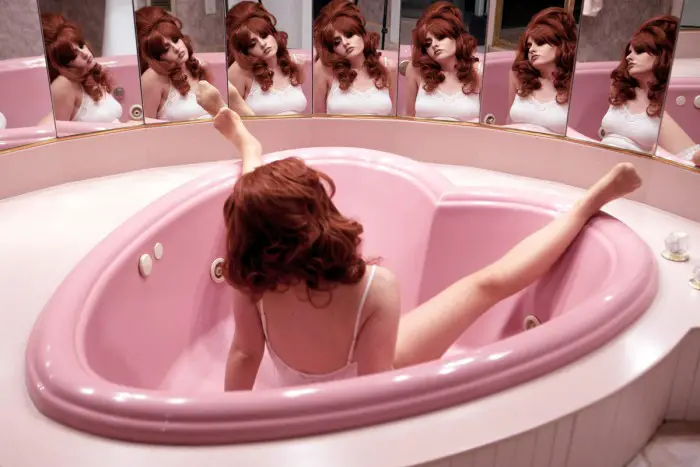Juno Calypso, a London-based photographer, explores the depths of femininity, desire and solitude through a series of extremely stylized photo series: “Joyce”, “The Honeymoon” and “What to do with a Million Years.”
All of Calypso’s photographs express an increasingly dynamic message. There is simplicity in the monochromatic schemes; when you first look at the photograph, there is a calming sense of unity in it. It is sharp and clean — she uses detail sparingly and only when it is entirely necessary. The work is perfectly stylized, literally down to the tee. However, the subjects of her work are motionless, indistinguishable and almost plastic.
There is a 1950s and ’60s mod feel to some of her pieces, especially in “The Honeymoon,” which was shot at a honeymoon-themed resort in suburban Pennsylvania. She, her own subject, models herself in typical pin-up style with voluptuous hair and coned bras. She lays in a heart-shaped, light pink bathtub, where she spreads her legs or observes herself in the 10-piece circular mirror, her clone present in each section. The use of the mid 1900s as inspiration functions to represent the birth of our modern-day perception of femininity, and the isolation and introspection that comes along with that.

During that time, American beauty standards had reached a new height of sexuality. Women were encouraged to gain weight, but only in the proper places, of course. A newfound sense of expectation arose, one that was centered around the idea of maintaining this sense of beauty and adhering to the standards while also continuing to practice the isolating stay-at-home-wife role.
Women at the time would dutifully shape and then reshape themselves, but for whom? Who were they to be doted upon or congratulated by? Themselves? This aspect of Calypso’s work supports the over-thematic foundation of her artistic intent. The focus on stylization is emphatic of this very idea: the stylization of femininity and the sense of solitude it bestows.
This is particularly evident in her “Joyce” collection. Here, Calypso steps into the role of Joyce, her alter ego, and places herself in his entirely monotonous environment that is completely void of character and individuality. She remains faceless throughout most of the photographs, covering her identifiable features with LED face masks or books. She becomes the ultimate housewife, forced to pass the time partaking in dull activities.
Calypso shows through her work what most people saw back then (and perhaps still today), which is this understanding of femininity through a singular lens and idea. It is not considered something dynamic and alive, but is instead thought to be this almost robotic, rule-following entity.
“What to do with a Million Years” offers a different perspective on the same overall theme. Calypso ventured out to Nevada to live in the extravagant bunker built by Gerry Anderson in the 1960s, a preemptive measure taken against the very real threat of nuclear warfare during the Cold War. The space, completely underground, is nothing shy of incredible. Juno Calypso picked the space for a variety of reasons; the first being the stylized interior of the house, which she described as an almost movie-like setting. However, the most prominent feature of the space is its desire for immortality.
Anderson, the former owner of the bunker, also owned Avon, one of the leading cosmetic companies of the time. His dedication to beauty is reflected in the lavish additions to the living space, as there is a swimming pool, guest house and artificial garden. Perhaps Calypso saw the bunker as a testament to the extreme lengths people will go to preserve their youth and beauty.
The bunker is fundamentally indestructible and is able to withstand the degradation of outside forces and time; its confinement from the outside world leaves it permanently stuck in the particular time period when it was built. It is the ultimate age-defying playground and the perfect location to communicate Calypso’s agitation with that desire.
However, this begets the question — and it may be an obvious one — is anti-aging an entirely female problem?
Calypso told Dazed Digital, “I used to take pictures of Joyce as a way of making a critique on the labored construction of femininity, but now I’m starting to see that the problem isn’t the make up and the bizarre body improvement devices, but the way society treats women who invest so deeply in their appearance.”
There is, and truly has never been, an appeal for a natural sense of beauty, one that exists in the various forms of personality, interests or intelligence of different women. Calypso’s work, nonetheless profoundly captivating, digs with manicured nails at the enigmatic nature of constructed beauty. One can literally feel the sense of imprisonment that Calypso’s muses are subject to. There is a palpable feeling of loneliness and sheer boredom that is masked behind the fanciful — and girly — decorations that adorn the scene.
The question then remains: What is the plan of escape?
















